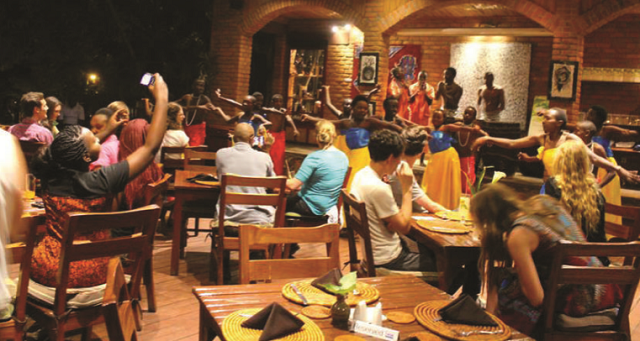
They concentrate on teaching the traditional music and what each of them means to children
Any visitor to Rwanda will be struck by the sounds and rhythms of different kinds of traditional music played even in the capital city Kigali.
Though Rwanda has different kinds of music today, traditional music still stands out as an essential part of Rwandan culture.
It is played on traditional instruments like ingoma, inanga, umuduli, iningiri and icyembe.
Walking around the Kacyiru suburbs of Kigali city on a typical evening, you are likely to hear the vibrating sounds of loud, talking drumbeats emanating from different arts centers spread here.
Conspicuously, often, you will likely see a group of tourists sitting around in groups as they enjoy these scintillating dance performances at the arts centers.
“I like the way they express themselves through music. The performance is eclectic. You cannot find this kind of performance in my country,” says Mia Sauer, a German tourist after watching a dance performance at Niyo Arts Center in Kacyiru by Niyo Children Dance Troupe.
Elias Kalinda a traditional dance teacher at Niyo says the dance sessions serves to preserve Rwanda’s rich traditional culture.
According to Moses Asiimwe, a blogger, the most famous traditional dances are intore and amaraba, both highly choreographed routines consisting of three components: the ballet, performed by women; the dance of heroes, performed by men, and the drums. Usually men are helped by women in performing the amaraba dance. Men beat drums in groups of seven to nine. This was the order of Rwandan traditional music blessed by the umwami, a king of Rwanda in the pre-colonial period.
Just as they do at Niyo, Inema or Ivuka art centers where each of these have their own respective dance troupes, these children mostly dance the traditional dances which are always accompanied by traditional songs, known as indirimbo in Kinyarwanda. Indirimbo songs consist of many categories, the most popular being those in praise of a dynasty (urugera), pastoral songs (amahambo), choral songs (ibihozo), lullabies, love songs, songs of complaint, hunting songs (amahigi) warriors’ songs (indirimbo z’ingabo), songs accompanying war dances (indirimbo z’intare) and wrestling songs (amusare).
Kalinda says at Niyo, they concentrate on teaching the traditional music and what each of them means to children.
“These children are young ambassadors of our rich cultural heritage. They showcase our culture to the world; making other people from different parts of the world who come here to appreciate our rich culture,” says Kalinda.
Ruth Uwingabiye, a Primary 6 student at a Kacyiru based local school says she normally looks forward to these performances since they provide her with something to do after school.
“Not only do I sometimes get money after performing to tourists but since I have nothing to do at home in the evening after school, I have a great opportunity to bond with my peers with whom we share common interest,” says Uwingabiye.
Anette Kaberuka is also involved in the cultural dances. She is just 13 year old and her typical day starts very early in the morning when she wakes up to attend school. She says she already knows education is “the key that will open the door to many opportunities in the future”.
When it comes to evening, she doffs her school uniform and heads to Inema Arts Center in Kacyiru, where she joins a group of her peers to hone her dancing skills.
On Fridays or Saturdays, they board a bus and head to Heaven Restaurant in Kiyovu where for one hour; from 7pm in the evening, they dance for tourists, who in return, as a token of appreciation, drop money in the open traditional collection baskets passed liberally among the excited tourists, even as they continue to take their dinner and at the same time watch the exhilarating traditional dancing performance.
Later, after the performances, the money is shared equally among the young performers from where they buy scholastic materials like text books, exercise books and pens among others.
“I come from a poor family, and my parents are unable to buy me all the things I need in school. I use my talents to enable me ease their burden,” says Kaberuka.
Whenever tourists drop some money inside collection baskets strategically placed at the dancing scene, little do they know the money goes a long way in helping these children towards their education, some of them who come from poor vulnerable households and preserving the traditional culture of a nation.
****
editor@independent.co.ug
 The Independent Uganda: You get the Truth we Pay the Price
The Independent Uganda: You get the Truth we Pay the Price



